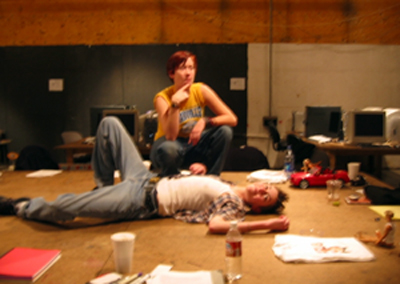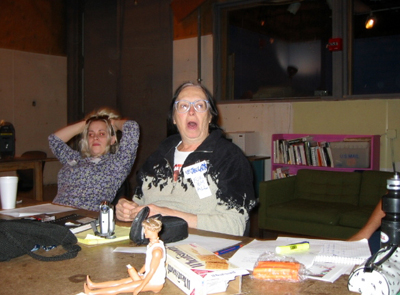Spring 2004
Trans: Dangerous Border Violations >> Cunt Brother, Je Hye's Home
1st Project >>
A Boalian Workshop for Resculpting Genders
- Body as a site of oppression or transgression/revolution
Inspired by Augusto Boal’s Image theatre, Judith Butler’s
gender performativity, and imagination of multi-gender system.
Boal notes that one gets to
know one’s body, its limitations and possibilities, its social
distortions and possibilities of rehabilitation of
body, by a series of exercise (Theatre of the Oppressed, 1985:
126). The mechanization(discipline) of body in Boal’s framework
can be specifically understood in terms of Butler’s DOING gender.
That is, if normative binary gender is inscribed or written in our body,
if we understand the conventional gender practice as “constructed
naturalness”, we can also explore new alternative gender
practices. It resonates poignantly with Butler’s conceptualization
of hetero-normative gender as “regulatory fiction” or “repeated
practices” and “drag” as a subversive gender performance.
The purpose of this workshop
is to defamiliarize ways in which we wear (embody) the binary
gender and to imagine how to take off gender and perform new
gender variations.
About Boal:
Augusto Boal is a Brazilian theatre practitioner and theorist who invented
a serial theatrical techniques and methods, called “Theatre of
the Oppressed (TO)”, which attempts to transform the oppressed
spectators into “spect-Actors” as a subject. Thus, TO opposes
to the separation actors from audiences: There is no passive spectator
in TO. Boal asserts that spect-actors can rehearse revolution through
the body expression/exercise of TO, and reclaims theatre as a weapon
of social change for the oppressed. To enhance the expressive capability
and sensibility of body, most TO techniques and games are required to
do non-verbal body work.
- Terms:
Jocker: facilitator in TO workshop. But her/his role is a helper,
not an instructor or teacher or critical commentator.
Participant as (sepct-) actor: all members in workshop. The principle
of TO is all’s participation.
Gamesercise: Boal’s compound word of ‘game’ (extroversive
dialogue, expressivity of body) and ‘exercise’ (introversive
monologue, physical reflection). So it’s a combination of the
two, which indicates diverse physical techniques for TO participants.
(Augusto Boal, Games for Actors and Non-Actors, Routledge,
1992: 60)
- Sculpting Body:
1) Two people make a pair.
2) A (one) is a sculptor and B (the other) becomes a sculpture.
3) A creates body sculpture (posture/gesture) of a normative/conventional
female or male gender (still image) with B’s body including
facial expression (if needed). This should be done in silence. Instead,
you can show your own gesture to the person B so that the person B
can imitate it Or you (A) can sculpt the person B, by yourself (treat
other’s body respectfully.).
4) After that, A (sculptor) re-sculpts and transforms B: Queer
or transgenderize or free the gender!!!
Breaking the conventional gender codes and remaking new codes.
5) Exchanging the role: B is a sculptor and A is a sculpture.

- Renaming our own gender(s):
1) The facilitator distributes pieces of small adhesive paper sticker)
to the participants and give them a few minutes to think about their
own gender identity.

2) Participants rename their own gender (or ideal one) other than
‘woman’ or ‘man’, trying to redefine it creatively
with their own terms.
[ex) Gender-juggler? Beyond & within? Deviant player? Dykewomyn?
The third in-between? Gender bending advocate? The way I am? Gender
destabilizer? ]
ANYTHING EXCEPT ‘Woman’ or ‘Man’ IS OK!
***Also, they can have several names
at the same time!!!***

3) Participants attach the sticker on their body and look around each
other for a minute.

4) And then all participants explain briefly why they name their gender
identity like that and what the word (on the sticker) means.
- Collaborating with the images:
1) Make groups by a similar category of the sticker.
2) Take a minute to think about how you can express your own gender
name with your own body.
3) Make an image of it, one by one (no fixed order).
That is, if you have five people in a group, the first person make
a body image and the next person adds her/his own image to the first
one, regarding the relationship and interplay between them.
Consider the distance or direction or gaze
or the degree of commonality…etc. between the image
(*** It doesn’t mean necessarily harmony or unification or uniformation!!!
***). and the third, forth, fifth person do that.
In short, it is to create a constellation
(family) of the similar gender names as a one big synthesizing image
like a kind of body installation in group.
3) Other groups observe the image closely
and discuss what they saw and what they felt…etc) and share the
feedback
|



